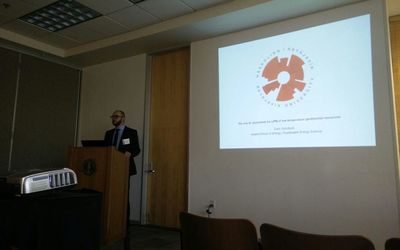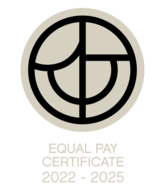RU at Stanford Geothermal Workshop
The 40th Annual Stanford Geothermal Workshop took place in Stanford, California, USA this past January. Students had the opportunity to present their thesis work and represent the Iceland School of Energy in various workshops.
Almar Barja presented a review of the Hveragerði district heating system and the main operational problems faced throughout its history. He reviewed scaling mechanisms and performed an in depth analysis of scales in a heat exchanger. Assessment of design flaws in the system and proposals for improvements on the sustainability of the area were also discussed during the conference.
Sven Scholtysik also presented thesis work and describes the main topic as “the relationship between changing uncertainty and lumped parameter modelling, as well as economic optimization of low temperature geothermal resources”. He mentions one of the variables in the customized cost-benefit model is the reservoir's physical reaction to production, which influences the optimization outcome. Sven adds that the lumped parameter model identifies the complexity of the best fit for four low temperature reservoirs in Iceland in order to test how much information is needed to produce good forecasting results.
v

Sven Scholtysik presenting his thesis work at the conference
Jón Pétursson attended the conference in support of the fellow students in the Iceland School of Energy, as well as for learning and networking opportunities. Highlights from the conference were acquiring knowledge about the different projects currently happening around the world and having a fun time meeting the people spearheading these ambitions. Jón adds that “since Iceland has been a forerunner in geothermal utilization for such a long time, people from other countries are interested in talking to Icelanders”.
A lecture series that stood out amongst the attendees was entitled “Assessment of New Approaches in Geothermal Exploration Decision Making”. The discussion went over the decision making processes from the proposal phase all the way to the production phase of a geothermal field. The main focal point was about when a decision maker should cut the losses throughout a project lifetime. This was through analysing an approach to a Go/No-Go curve; explaining that if the Net Present Value (NPV) of the project falls under the curve as the project progresses, then it should be abandoned.
The gentlemen conclude that the experience has positively impacted their professional careers. As presenters, it was good practice in public speaking and obtaining confidence in their work. The conference provided an open door for several opportunities in interesting destinations to send job applications. Networking has sparked varying discussions to gain insight into topics from new points of view; a great skill to have in the workforce.
In general, Sven sums up the experience as a “great [feeling] to be able to present the individual research results while simultaneously spreading the word about ISE and its interdisciplinary approach”. Almar adds “it is always nice to be able to represent an institution you like and being from Iceland you feel like you have so much to offer in terms of sustainability and experience from utilizing geothermal energy”. Jón says that “seeing two of my fellow students from the Iceland School of Energy presenting was my favourite part”. Overall, a fun time was had by all and we are excited to see where their paths lead next.

